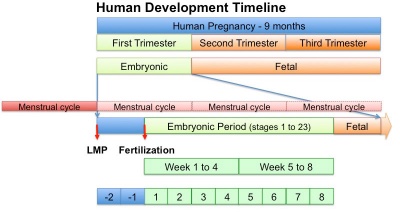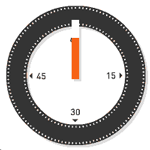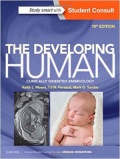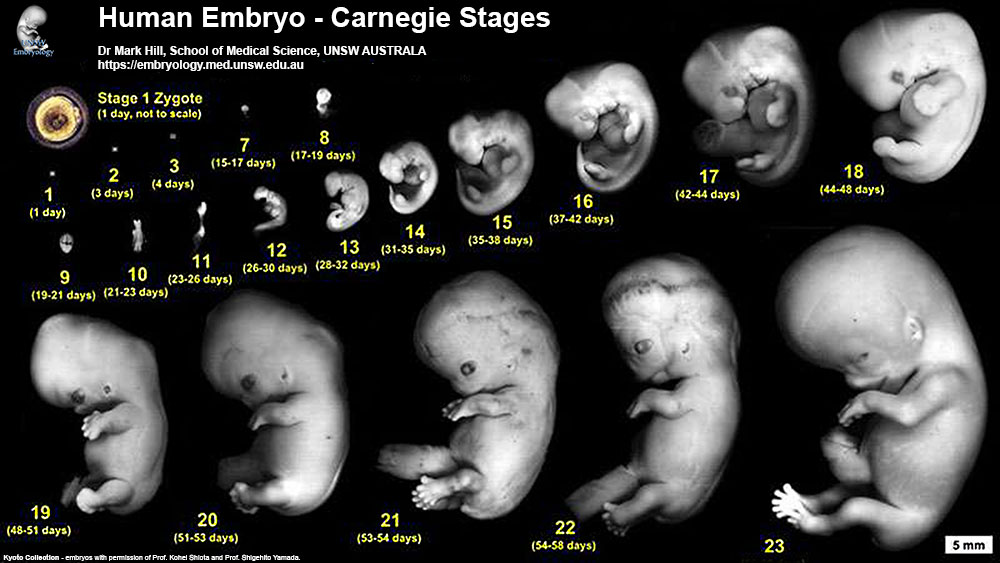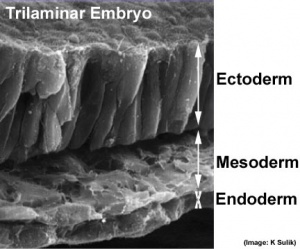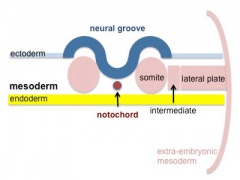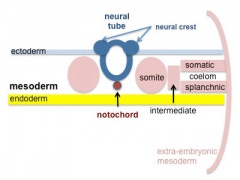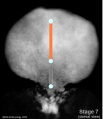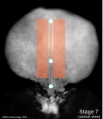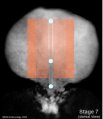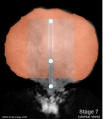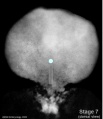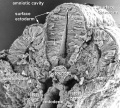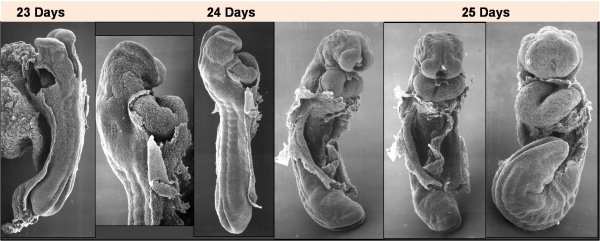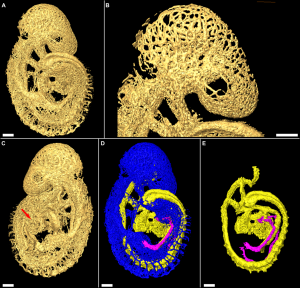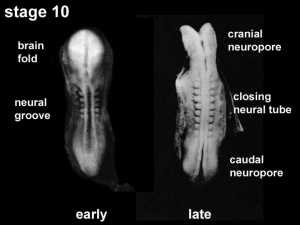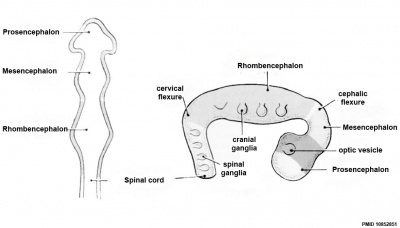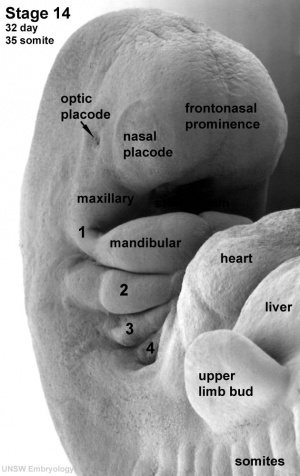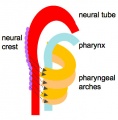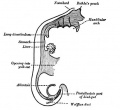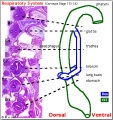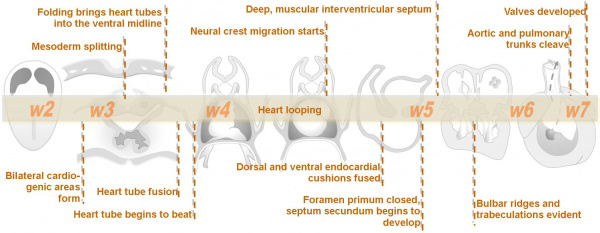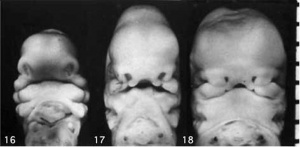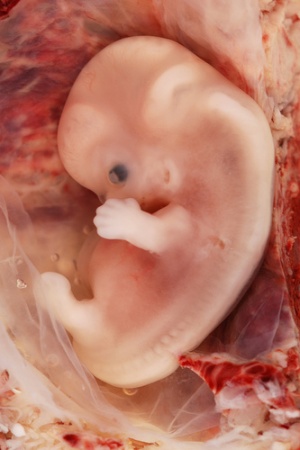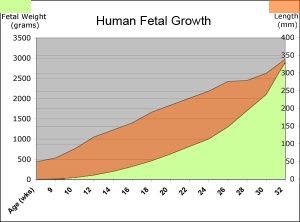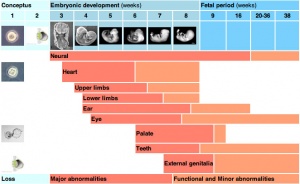BGDA Lecture - Development of the Embryo/Fetus 2
| Embryology - 1 May 2024 |
|---|
| Google Translate - select your language from the list shown below (this will open a new external page) |
|
العربية | català | 中文 | 中國傳統的 | français | Deutsche | עִברִית | हिंदी | bahasa Indonesia | italiano | 日本語 | 한국어 | မြန်မာ | Pilipino | Polskie | português | ਪੰਜਾਬੀ ਦੇ | Română | русский | Español | Swahili | Svensk | ไทย | Türkçe | اردو | ייִדיש | Tiếng Việt These external translations are automated and may not be accurate. (More? About Translations) |
Introduction
This lecture covers the period of Embryonic development, in Humans from week 3 to week 8 (GA week 5-10) and is divided into 23 Carnegie stages of embryonic development. There will also be a brief introduction to fetal development. Note, the period from week 9 to week 38 is considered Fetal development and will be covered in detail in the Laboratory 12.
Lecture Objectives
- Understand key structures and events in embryonic development.
- Understanding of the dynamic changes internal and external structures.
- Brief understanding of organ and system formation (functional / not functional).
- Brief understanding of critical periods of development.
1 Minute Embryology | UNSW theBox
| Lecture Archive |
|---|
| [Media:2018 BGDA Lecture - Development of the Embryo-Fetus 2.pdf 2018 PDF] | 2017 | 2017 PDF |
2016 | 2015 | 2014 | 2014 PDF | 2013 | 2012 | 2010 | Practical 6 Embryonic Development | Practical 12 Fetal Development |
BGDA Practical Classes
| Practical 3 - Fertilization to Implantation | Practical 6 - Implantation to 8 Weeks | Practical 12 - Fetal Period |
First 8 Weeks
The Carnegie stages of the first 8 week of human development.
Week 3
Mesoderm means the "middle layer" and it is from this layer that the body's connective tissues are derived (note that the head neural crest ectoderm also forms connective tissues)
In early mesoderm development a number of transient structures will form and then be lost as tissue structure is patterned and organised.
Humans as vertebrates have a "backbone" and the first mesoderm structure we will see form after the notochord will be somites.
- Mesoderm and Ectoderm Cartoons
Mesoderm organization: (left to right)
lateral plate - intermediate mesoderm - paraxial mesoderm - axial mesoderm - paraxial mesoderm - intermediate mesoderm - lateral plate
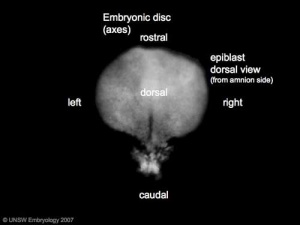
|
|
Axial Mesoderm

|
Adult - contributes to the nucleus pulposis of the intervertebral disc |
|
Paraxial Mesoderm
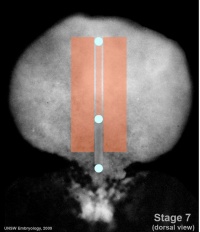
|
|
Intermediate Mesoderm
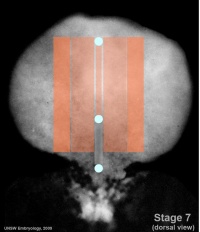
|
Adult - metanephros forms the renal kidney |
Lateral Plate Mesoderm

|
Adult - body connective tissues, gastrointestinal tract (connective tissues, muscle, organs), heart |
Week 4
Somite Development
Somite initially forms 2 main components
- ventromedial- sclerotome forms vertebral body and intervertebral disc
- dorsolateral - dermomyotome forms dermis and skeletal muscle
| Sclerotome | Dermatome |
|---|---|
|
|
| Myotome | |
|
Heart
| Heart Development Movies | ||||||||||||||||||||
|---|---|---|---|---|---|---|---|---|---|---|---|---|---|---|---|---|---|---|---|---|
|
- forms initially in splanchnic mesoderm of prechordal plate region - cardiogenic region
- growth and folding of the embryo moves heart ventrallly and downward into anatomical position
- week 3 begins as paired heart tubes that fuse to form single heart tube
- begins to beat in Humans- day 22-23
- heart tube connects to blood vessels forming in splanchnic and extraembryonic mesoderm
Week 2-3 pair of thin-walled tubes
Week 3 tubes fused, truncus arteriosus outflow, heart contracting
Week 4 heart tube continues to elongate, curving to form S shape
Week 5 Septation starts, atrial and ventricular
- Links: Cardiac Embryology
Neural
- Mesoderm and Ectoderm Cartoons
Neural Plate
|
Neural Groove
- forms in the midline of the neural plate (day 18-19)
- either side of which are the neural folds which continues to deepen until about week 4
- neural folds begins to fuse, beginning at 4th somite level
Neural Tube
Failure for the neural tube to close correctly or completely results in a neural tube defect. |

|
Neural - 3 primary vesicles
Neural Crest
- population of cells at the edge of the neural plate that lie dorsally when the neural tube fuses
- dorsal to the neural tube, as a pair of streaks
- pluripotential, forms many different types of cells
- cells migrate throughout the embryo
Neural Crest Derivatives: dorsal root ganglia, autonomic ganglia, adrenal medulla, drg sheath cells, glia, pia-arachnoid sheath, skin melanocytes, connective tissue of cardiac outflow, thyroid parafollicular cells, craniofacial skeleton, teeth odontoblasts
Head
- branchial arch (Gk. branchia= gill)
- arch consists of all 3 trilaminar embryo layers (ectoderm- outside, mesoderm - core of mesenchyme, endoderm - inside)
- Humans have 5 arches - 1, 2, 3, 4, 6 (Arch 5 does not form or regresses rapidly)
- from in rostro-caudal sequence, Arch 1 to 6 from week 4 onwards
- arch 1 and 2 appear at time of closure of cranial neuropore
- Face - mainly arch 1 and 2
- Neck components - arch 3 and 4 (arch 4 and 6 fuse)
Sensory Placodes
- During week 4 a series of thickened surface ectodermal patches form in pairs rostro-caudally in the head region.
- These sensory placodes will later contribute key components of each of our special senses (vision, hearing and smell).
- Note that their initial postion on the developing head is significantly different to their final position in the future sensory system
- Otic placode - istage 13/14 embryo the otic placode sunk from the surface ectoderm to form a hollow epithelial ball, the otocyst, which now lies beneath the surface surrounded by mesenchyme (mesoderm). The epithelia of this ball varies in thickness and has begun to distort, it will eventually form the inner ear membranous labyrinth.
- Lens placode - lies on the surface, adjacent to the outpocketing of the nervous system (which will for the retina) and will form the lens.
- Nasal placode - has 2 components (medial and lateral) and will form the nose olefactory epithelium.
Upper and Lower Limb
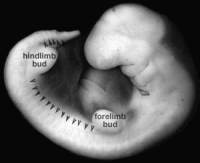
|
|
Gastrointestinal Tract
- Begins at buccopharyngeal membrane
- Ends at cloacal membrane
- 3 distinct portions (fore-, mid- and hind-gut)
- liver earliest forming organ
Germ layer contributions
- Endoderm - epithelium and associated glands
- Mesoderm (splanchnic) - mesentry, connective tissues, smooth muscle, blood vessels
- Ectoderm (neural crest) - enteric nervous system
Both endoderm and mesoderm will contribute to associated organs.
Week 5
- Heart - septation starts, atrial and ventricular
- Vascular - 3 vascular systems (systemic, placental, vitelline) extensively remodelled
- Respiratory - left and right lung buds push into the pericardioperitoneal canals (primordia of pleural cavity)
- Sense - Hearing cochlear part of otic vesicle elongates (humans 2.5 turns)
Atrial septa remains open, foramen ovale, septation continues (week 5-7),
<html5media height="720" width="560">File:Heart septation 003.mp4</html5media>
Week 6
- Endocrine development
- pituitary - connecting stalk between pouch and oral cavity degenerates
- parathyroid - diverticulum elongate, hollow then solid, dorsal cell proliferation
- thymus - diverticulum elongate, hollow then solid, ventral cell proliferation
- adrenal - fetal cortex forms from mesothelium adjacent to dorsal mesentery, medulla neural crest cells from adjacent sympathetic ganglia
Week 7
- pancreas - Week 7 to 20 pancreatic hormones secretion begins and increases, small amount maternal insulin
- limb bones form by endochondrial ossification and throughout embryo replacement of cartilage with bone (week 5 onward; bone timeline)
Week 8
| Sagittal GIT |
| Page | Play |
- Limb - upper and lower limbs rotate in different directions (upper limb dorsally, lower limb ventrally)
Links: Embryonic Development | Timeline human development
Fetal
Note - Fetal development topic will be covered in detail in practical 12 - Fetal. Information below is only a brief summary and may not be covered in this lecture.
- First Trimester (1 - 12 weeks) - embryonic and early fetal
- Second Trimester (13 - 24 weeks) - organ development, function, and growth (length)
- Third Trimester (25 - 40 weeks) - organ function and rapid growth (weight)
Fetal Neural
- During the fetal period there is ongoing growth in size, weight and surface area of the brain and spinal cord. Microscopically there is ongoing: cell migration, extension of processes, cell death and glial cell development.
- Brain - folding of the initially smooth surface (insular cortex, gyral and culcal development)
- Neural development will continue after birth with substantial growth, death and reorganization occuring during the postnatal period
- Links: neural | BGDA Lecture - Nervous System
Lung Stages
- week 4 - 5 embryonic
- week 5 - 17 pseudoglandular
- week 16 - 25 canalicular
- week 24 - 40 terminal sac
- late fetal - 8 years alveolar
| Lung Stages (detailed) | |||||||||||||||||||||||||||||
|---|---|---|---|---|---|---|---|---|---|---|---|---|---|---|---|---|---|---|---|---|---|---|---|---|---|---|---|---|---|
| |||||||||||||||||||||||||||||
- Links: respiratory | SH Lecture - Respiratory
Fetal Genital
- Gonad - ovary and testis development
- Internal genital tract - uterus and ductus deferens
- External genital tract - genital folds development
- Testis descent
- Links: genital | BGDB Lecture - Genital
Fetal Renal
- week 32-34 nephron development completed
- term birth nephron number per kidney about 1 million (300,000 to 2 million)
- Links: renal
Fetal Endocrine
- Many endocrine organs begin to function in the early fetal period.
- Pituitary hormones - HPA axis established by week 20, pituitary functional throughout fetal development
- Thyroid hormone - important for neural development, required for metabolic activity, also in the newborn
Remember that the Placenta also has important endocrine functions during development.
Critical Periods
The term "Critical Periods" refers to periods of development when specific systems are more sensitive to teratogen exposure or developmental insults.
| Critical Periods of Human Development | ||||||||||||||||||||
|---|---|---|---|---|---|---|---|---|---|---|---|---|---|---|---|---|---|---|---|---|
| Conceptus | Embryonic development (weeks) | Fetal period (weeks) | ||||||||||||||||||

|
||||||||||||||||||||
| Neural | ||||||||||||||||||||
| Heart | ||||||||||||||||||||
| Upper limbs | ||||||||||||||||||||
| Lower limbs | ||||||||||||||||||||
| Ear | ||||||||||||||||||||
| Eye | ||||||||||||||||||||
| Palate | ||||||||||||||||||||
| Teeth | ||||||||||||||||||||
| External genitalia | ||||||||||||||||||||
| Loss | Major abnormalities | Functional and Minor abnormalities | ||||||||||||||||||
| ||||||||||||||||||||
Additional Information
See the associated BGDA Practical 6 class.
Links: human timeline | first trimester timeline | second trimester timeline | third trimester timeline | fetal | Template:Movies
| Abnormality Links: abnormal development | abnormal genetic | abnormal environmental | Unknown | teratogens | ectopic pregnancy | cardiovascular abnormalities | coelom abnormalities | endocrine abnormalities | gastrointestinal abnormalities | genital abnormalities | head abnormalities | integumentary abnormalities | musculoskeletal abnormalities | limb abnormalities | neural abnormalities | neural crest abnormalities | placenta abnormalities | renal abnormalities | respiratory abnormalities | hearing abnormalities | vision abnormalities | twinning | Developmental Origins of Health and Disease | ICD-11 | ||
|
| First Trimester Timeline | |||||||||||||||||||||||||||||||||||||||||||||||||||||||||||||||||||||||||||||||||||||||||||||||||||||||||||||||||||||||||||||||||||||||||||||||||||||||||||||||||||||||||||||||||||||||||||||||||||||||||||||||||||||||||||||||||||||||||||||||||||||||||||||||||||||||||||||||||||||||||||||||||
|---|---|---|---|---|---|---|---|---|---|---|---|---|---|---|---|---|---|---|---|---|---|---|---|---|---|---|---|---|---|---|---|---|---|---|---|---|---|---|---|---|---|---|---|---|---|---|---|---|---|---|---|---|---|---|---|---|---|---|---|---|---|---|---|---|---|---|---|---|---|---|---|---|---|---|---|---|---|---|---|---|---|---|---|---|---|---|---|---|---|---|---|---|---|---|---|---|---|---|---|---|---|---|---|---|---|---|---|---|---|---|---|---|---|---|---|---|---|---|---|---|---|---|---|---|---|---|---|---|---|---|---|---|---|---|---|---|---|---|---|---|---|---|---|---|---|---|---|---|---|---|---|---|---|---|---|---|---|---|---|---|---|---|---|---|---|---|---|---|---|---|---|---|---|---|---|---|---|---|---|---|---|---|---|---|---|---|---|---|---|---|---|---|---|---|---|---|---|---|---|---|---|---|---|---|---|---|---|---|---|---|---|---|---|---|---|---|---|---|---|---|---|---|---|---|---|---|---|---|---|---|---|---|---|---|---|---|---|---|---|---|---|---|---|---|---|---|---|---|---|---|---|---|---|---|---|---|---|---|---|---|---|---|---|---|---|---|---|---|---|---|---|---|---|---|---|---|---|---|---|---|---|---|---|---|---|---|---|---|---|
Embryonic Weeks/Stages
| |||||||||||||||||||||||||||||||||||||||||||||||||||||||||||||||||||||||||||||||||||||||||||||||||||||||||||||||||||||||||||||||||||||||||||||||||||||||||||||||||||||||||||||||||||||||||||||||||||||||||||||||||||||||||||||||||||||||||||||||||||||||||||||||||||||||||||||||||||||||||||||||||
| |||||||||||||||||||||||||||||||||||||||||||||||||||||||||||||||||||||||||||||||||||||||||||||||||||||||||||||||||||||||||||||||||||||||||||||||||||||||||||||||||||||||||||||||||||||||||||||||||||||||||||||||||||||||||||||||||||||||||||||||||||||||||||||||||||||||||||||||||||||||||||||||||
References
| |||||||||||||||||||||||||||||||||||||||||||||||||||||||||||||||||||||||||||||||||||||||||||||||||||||||||||||||||||||||||||||||||||||||||||||||||||||||||||||||||||||||||||||||||||||||||||||||||||||||||||||||||||||||||||||||||||||||||||||||||||||||||||||||||||||||||||||||||||||||||||||||||
BGDA: Lecture 1 | Lecture 2 | Practical 3 | Practical 6 | Practical 12 | Lecture Neural | Practical 14 | Histology Support - Female | Male | Tutorial
Glossary Links
- Glossary: A | B | C | D | E | F | G | H | I | J | K | L | M | N | O | P | Q | R | S | T | U | V | W | X | Y | Z | Numbers | Symbols | Term Link
Cite this page: Hill, M.A. (2024, May 1) Embryology BGDA Lecture - Development of the Embryo/Fetus 2. Retrieved from https://embryology.med.unsw.edu.au/embryology/index.php/BGDA_Lecture_-_Development_of_the_Embryo/Fetus_2
- © Dr Mark Hill 2024, UNSW Embryology ISBN: 978 0 7334 2609 4 - UNSW CRICOS Provider Code No. 00098G
